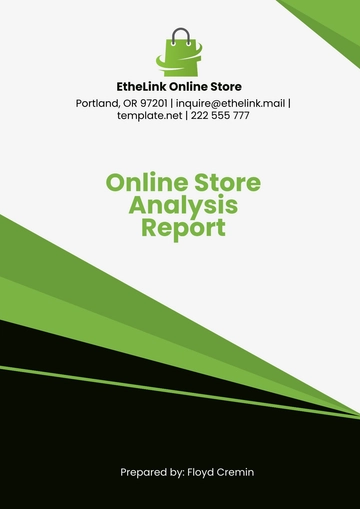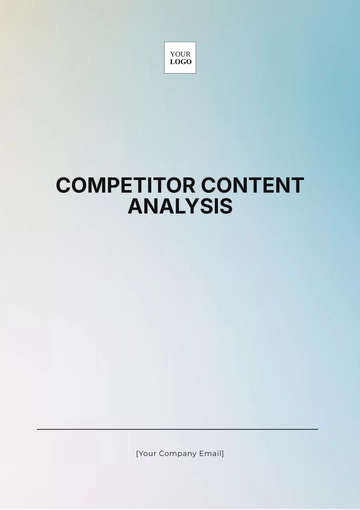Free Salon Social Media Engagement Analysis

I. Introduction
In the contemporary digital landscape, social media has emerged as a powerful tool for businesses to engage with their customers. This is particularly true in lifestyle sectors such as the salon industry. This report provides a comprehensive analysis of the social media engagement of [Your Company Name].
A. Objective
The primary objective of this analysis is to identify the strengths and potential areas for improvement within [Your Company Name]'s current social media tactics. The aim is to enhance the salon’s overall online presence and customer engagement.
Identifying strengths: The first step in the analysis is to identify the strengths of [Your Company Name]'s current social media tactics. This includes aspects such as high engagement rates, a large follower base, and positive audience feedback.
Identifying areas for improvement: The next step is to identify areas where [Your Company Name] could improve its social media tactics. This could include aspects such as low engagement rates on certain platforms, slow follower growth, or negative audience feedback.
Enhancing online presence: By identifying strengths and areas for improvement, the analysis aims to provide recommendations on how [Your Company Name] can enhance its overall online presence.
Enhancing customer engagement: The ultimate goal of improving [Your Company Name]'s social media tactics is to enhance customer engagement. This includes attracting more followers, increasing interaction with posts, and ultimately, converting followers into customers.
B. Scope
In addition, this analysis will explore how these strategies contribute to key business outcomes, including service bookings, client retention, and brand loyalty.
Service bookings: One of the key business outcomes that social media strategies can influence is service bookings. By showcasing their services and engaging with their audience, salons can attract more customers to book their services.
Client retention: Social media strategies can also contribute to client retention. By building relationships with their audience and making them feel valued, salons can increase the likelihood of clients returning for more services.
Brand loyalty: Finally, effective social media strategies can contribute to building brand loyalty. By consistently posting engaging content and interacting with their audience, salons can build a loyal following of customers who are likely to choose their services over competitors.
Competitive advantage: In the competitive salon industry, having a strong social media presence can provide a significant advantage. It can help salons stand out from their competitors, attract more customers, and build a strong brand image.
Business growth: Ultimately, all of these factors contribute to business growth. By attracting more customers, retaining existing clients, and building brand loyalty, salons can increase their revenue and grow their business.
II. Methodology
The methodology for this analysis is designed to provide a comprehensive and detailed understanding of [Your Company Name]'s social media engagement. It involves a multi-faceted approach that encompasses various aspects of social media presence and audience interaction.
A. Platform Analysis
The first step in the methodology involves a thorough review of the salon’s presence across various social media platforms. These platforms include, but are not limited to:
Facebook: As one of the most widely used social media platforms, Facebook provides a broad audience base for [Your Company Name]. The analysis on this platform focuses on the salon’s posts, audience reactions, and engagement metrics. It also examines the frequency of posts and the timing of these posts to understand when the salon’s audience is most active.
Instagram: Known for its visual appeal, Instagram is a crucial platform for salons. The analysis here revolves around the visual content posted by the salon, the use of relevant hashtags, and audience engagement. It also looks at the salon’s Instagram Stories and Highlights to assess how effectively these features are being used.
Twitter: Twitter’s real-time interaction makes it a valuable platform for customer service and quick updates. The analysis on Twitter involves examining the salon’s tweets, retweets, likes, and replies. It also considers the use of hashtags and mentions to understand how the salon is connecting with its audience and participating in larger conversations.
Pinterest: With its focus on inspiration and ideas, Pinterest is a great platform for showcasing the salon’s work. The analysis on Pinterest involves reviewing the salon’s pins, boards, and follower engagement. It also looks at how the salon is using Pinterest’s unique features, such as creating themed boards or using rich pins.
B. Key Performance Indicators
Key performance indicators (KPIs) serve as measurable values that demonstrate the effectiveness of the salon’s social media strategies. These KPIs include:
Engagement Rate: This measures the level of interaction content receives from the audience. It’s calculated based on the total engagement (likes, comments, shares) a post receives. A higher engagement rate indicates that the salon’s content is resonating with its audience and prompting them to interact.
Follower Growth: This tracks the increase or decrease in the salon’s follower count over a specified period. Rapid follower growth can indicate that the salon’s social media strategies are effective at attracting new audience members, while slow growth or a decline in followers could signal a need for strategy adjustment.
Content Variety: This assesses the range of content types (images, videos, text posts, etc.) the salon uses across its social media platforms. A diverse content mix can help keep the audience engaged and interested, while a lack of variety could lead to audience disinterest over time.
User Interaction: This measures the frequency and quality of the salon’s interactions with its audience, such as responding to comments or direct messages. Regular, meaningful interactions can help build strong relationships with the audience and foster a sense of community around the salon’s brand.
C. Data Collection
Data for the analysis were collected through a combination of:
Social Media Analytics Tools: These tools provide quantitative data such as engagement rates, follower counts, and post reach. They can offer valuable insights into the salon’s social media performance and help identify trends or patterns over time.
Direct Feedback Mechanisms: These include comments, direct messages, and reviews left by the audience on the salon’s social media posts. This qualitative data can provide insights into the audience’s perceptions and opinions of the salon, and can be particularly useful for understanding the audience’s needs and preferences.
D. Comparative Benchmarks
The analysis also incorporates comparative benchmarks with top competitors within the same industry. This provides a relative performance perspective and helps identify areas where [Your Company Name] is excelling or lagging behind.
Competitor Analysis: This involves identifying key competitors and analyzing their social media strategies. Understanding what competitors are doing well can provide valuable insights for improving [Your Company Name]'s own strategies.
Benchmarking: This involves comparing [Your Company Name]'s KPIs with those of its competitors to identify gaps and opportunities. Benchmarking can help [Your Company Name] understand where it stands in the industry and identify areas for improvement.
E. Time Frame
The analysis was conducted over the last four months. This time frame allows for the tracking of trends and the measurement of growth or decline in key performance indicators. It also provides a recent snapshot of the salon’s social media performance, ensuring that the analysis is relevant and up-to-date.
III. Findings and Analysis
The analysis of [Your Company Name]'s social media engagement has yielded insightful findings. These findings, derived from a comprehensive review of the salon’s presence across various social media platforms, provide a clear picture of the salon’s current social media performance. The following table summarizes the key findings:
Platform | Engagement Rate | Follower Growth | Top Performing Content Type | User Interaction |
|---|---|---|---|---|
5.5% | 12% | Visuals & Live Sessions | High | |
3.2% | 9% | Client Testimonials | High | |
1.1% | 3% | Industry News | Moderate | |
0.5% | 1% | Inspirational Boards | Low |
A. Engagement Rates
Engagement rates, which measure the level of interaction content receives from the audience, varied significantly across platforms. Instagram led the pack with an impressive engagement rate of 5.5%, indicating that the salon’s visual content and live sessions are resonating well with the audience. Facebook followed with a respectable 3.2% engagement rate, suggesting that client testimonials are effectively engaging the audience. However, Twitter and Pinterest showed modest figures, indicating room for improvement in these platforms.
B. Follower Growth
Follower growth is a key indicator of the salon’s ability to attract and retain audience attention. Instagram and Facebook demonstrated a steady increase in followers, indicating the effectiveness of the salon’s strategies on these platforms. However, Twitter showed slight stagnation, and Pinterest exhibited minimal growth, suggesting the need for revised strategies to boost follower growth on these platforms.
C. Content Analysis
The analysis of the top-performing content types revealed distinct patterns across different platforms:
Instagram: The salon’s high-quality visuals and regular customer engagement through competitions and live sessions have proven to be highly effective, contributing to Instagram’s high engagement rate and follower growth.
Facebook: [Your Company Name] has effectively utilized Facebook for announcements and client testimonials, resulting in high user interaction.
Twitter: Serving mostly as an avenue for quick updates and industry news, Twitter’s content strategy could benefit from more interactive and engaging content.
Pinterest: Despite its low activity and irregular post updates, Pinterest holds potential for the salon to share inspirational boards and attract a wider audience.
D. User Interaction
User interaction is a critical measure of the salon’s ability to engage with its audience. The highest interaction rates were noted on Facebook and Instagram posts that included promotional offers and client aftercare tips. This suggests that the audience appreciates value-added content and is more likely to interact with posts that offer tangible benefits.
In addition to these specific insights, the analysis also revealed the importance of tailoring content strategies to the specific characteristics and user behaviors of each platform. By understanding and leveraging these differences, [Your Company Name] can optimize its content for each platform, thereby maximizing engagement and follower growth.
Furthermore, the analysis underscores the importance of maintaining a consistent and engaging social media presence. Regular posting, timely responses to user comments and messages, and the use of diverse and visually appealing content are all crucial for sustaining audience interest and fostering a loyal and engaged follower base. By implementing these strategies, [Your Company Name] can enhance its social media engagement, thereby driving greater brand awareness, customer loyalty, and business growth.
IV. Actionable Recommendations
Based on the findings from the analysis, several actionable recommendations can be made to improve [Your Company Name]'s social media engagement. These recommendations are designed to address the areas of improvement identified in the analysis and leverage the strengths to enhance overall performance.
A. Pinterest
Pinterest presents a significant opportunity for [Your Company Name] to expand its reach and engagement.
Increase Content Frequency: Given the visual-centric nature of Pinterest, increasing the frequency of content posting can help attract more followers and increase engagement. Regular posting can also help maintain visibility in followers’ feeds.
Diversify Content: Diversifying the type of content posted on Pinterest can help cater to a wider audience. This could include before-and-after transformations, hair care tips, trending hairstyles, and more.
Use Rich Pins: Rich Pins provide more context about an idea because they show extra information directly on the Pin. [Your Company Name] can use Rich Pins to automatically include information like prices, availability, and where to buy your product or service.
Engage with Users: Engaging with users by responding to comments and re-pinning user content can help build a loyal community on Pinterest.
B. Instagram
Instagram is currently [Your Company Name]'s strongest platform in terms of engagement. However, there are still ways to further enhance its performance.
Leverage High-Performing Content: Continue to leverage high-performing visual content by incorporating more behind-the-scenes videos and client transformation stories. This type of content has proven to be highly engaging for the audience.
Use Instagram Stories: Instagram Stories offer a great way to post updates and engage with followers without cluttering up the main feed. Consider using Stories for quick updates, behind-the-scenes looks, or to showcase client testimonials.
Engage with Followers: Regularly engage with followers by responding to comments and direct messages. This can help build a strong relationship with the audience and encourage more engagement.
Collaborate with Influencers: Collaborating with influencers can help reach a wider audience. Consider partnering with local influencers for giveaways or special promotions.
C. Facebook
Facebook is another platform where [Your Company Name] has strong engagement. The following recommendations can help enhance its performance.
Increase Interactive Content: Increase the amount of interactive content such as live Q&A sessions, polls, and giveaways. This type of content can help drive more engagement and make the audience feel more connected to the salon.
Use Facebook Groups: Facebook Groups can be a great way to build a community around the salon. Consider creating a group for clients to share their experiences, ask questions, and connect with each other.
Leverage User-Generated Content: User-generated content, such as client testimonials and before-and-after photos, can be highly engaging. Consider featuring this type of content on the salon’s Facebook page.
Optimize Posting Times: Analyze when the audience is most active and schedule posts for those times to increase visibility and engagement.
D. Twitter
While Twitter has lower engagement compared to Instagram and Facebook, it still offers valuable opportunities for [Your Company Name].
Maintain Consistency: Continue to maintain the consistency of Twitter content but consider integrating more interactive and real-time engagement strategies like Twitter chats.
Use Hashtags: Hashtags can help increase the visibility of tweets. Consider using popular and relevant hashtags to reach a wider audience.
Engage with Followers: Regularly engage with followers by responding to comments and retweeting user content. This can help build a strong relationship with the audience and encourage more engagement.
Promote Special Offers: Use Twitter to promote special offers or discounts. This can help attract new clients and encourage existing clients to try new services.
E. Cross-Platform Integration
Finally, enhancing integration across platforms can provide a seamless brand narrative and cross-platform user experience.
Consistent Branding: Ensure that branding is consistent across all platforms. This includes the salon’s logo, color scheme, and overall aesthetic.
Cross-Promotion: Use each platform to promote content on the others. For example, tease Instagram content on Facebook, or promote a Twitter chat on Instagram.
Unified Messaging: Ensure that messaging is consistent across all platforms. This includes the salon’s mission, values, and key marketing messages.
Seamless User Experience: Strive to provide a seamless user experience across all platforms. This includes things like making sure links work correctly, ensuring that content is optimized for each platform, and providing consistent customer service.
V. Conclusion
The analysis of [Your Company Name]'s social media engagement reveals a dynamic and evolving digital landscape. The salon has demonstrated substantial strengths in its social media strategies, particularly in terms of visual content engagement on Instagram and interaction mechanisms on Facebook. These strengths not only enhance [Your Company Name]'s online presence but also foster a strong connection with its audience, thereby driving customer loyalty and business growth.
However, the analysis also uncovers several opportunities for enhancement. Platforms like Pinterest and Twitter, while currently showing lower engagement, hold untapped potential for expanding [Your Company Name]'s digital reach. Furthermore, the need for a more integrated and cohesive cross-platform narrative is evident. By aligning the salon’s messaging and content across all platforms, [Your Company Name] can provide a seamless and engaging user experience.
In conclusion, social media presents a powerful opportunity for [Your Company Name] to connect with audience, showcase services, and build a strong brand. By leveraging the insights from this analysis and implementing the recommended strategies, [Your Company Name] can optimize its social media engagement, thereby enhancing its digital presence, attracting and retaining more customers, and driving greater business outcomes. The digital landscape is ever-changing, and it is crucial for [Your Company Name] to continue analyzing and adapting its strategies to stay ahead of the curve and maintain a strong connection with its audience.
- 100% Customizable, free editor
- Access 1 Million+ Templates, photo’s & graphics
- Download or share as a template
- Click and replace photos, graphics, text, backgrounds
- Resize, crop, AI write & more
- Access advanced editor
Enhance social media engagement with our Salon Social Media Engagement Analysis Template! This analytical tool from Template.net enables you to assess the effectiveness of your salon's social media engagement strategies. By leveraging the customizable features and AI Editor Tool, you can measure engagement metrics with ease! Grab your editable copy!





























